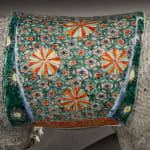A FAMILLE VERTE PORCELAIN MODEL OF A CAPARISONED ELEPHANT
Further images
Provenance
The Collection of Kurt Meyer, Los Angeles, USA c. 1929
Christie’s, London, 25 March 1974, lot 12
Exhibitions
Berlin, Chinesische Kunst, Preußische Akademie der Künste, 10 January - 2 April 1929
Publications
Chinesische Kunst, Berlin, 1929, p. 348, fig. 947
The elephant is naturalistically rendered with finely wrinkled skin in soft greyish-white and black tones. Its saddlecloth is exquisitely decorated in vibrant famille verte enamels and gilt, featuring an intricate geometric pattern interspersed with stylized floral roundels.
Elephants have long been favored in China as subjects for art, being sacred to the Buddhist faith and symbols of strength, wisdom and good fortune. The Chinese word for ‘elephant’ (xiang) sounds like the word for happiness, and the term for ‘saddle cloth’ (an) is a homonym for peace, and so elephant figurines carried auspicious connotations.
While famille rose and cloisonné enamel elephants are typical of the Qianlong period (1736-1795) and early nineteenth century, earlier famille verte examples are scarce, though elephants sometimes appear as motifs on vessels of this colouring. Notable examples include a Kangxi period elephant in the Victoria and Albert Museum and a Qianlong period elephant and vase group in the National Palace Museum, Taipei.
The result of Oxford thermoluminescence test no. P121h57 (13 July 2021) is consistent with the dating of this figure.





